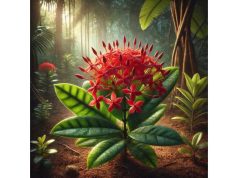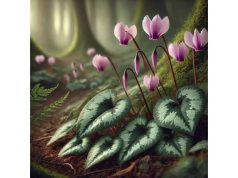
Indian Rhubarb is a storied medicinal herb celebrated for its potent healing properties and versatile applications. Revered in traditional medicine systems across Asia, it offers benefits that range from promoting healthy digestion and detoxification to alleviating inflammation and supporting liver function. The herb’s unique array of active compounds not only contributes to its remarkable therapeutic potential but also makes it a favored choice in natural and modern remedies. In this comprehensive guide, we explore the botanical profile, phytochemical richness, health advantages, practical applications, and scientific research behind Indian Rhubarb, providing you with an in-depth understanding of its diverse uses.
Table of Contents
- Floral Anatomy and Botanical Overview
- Phytochemical Profile and Active Ingredients
- Health Advantages and Intrinsic Qualities
- Practical Applications and Safety Considerations
- Research Findings and Notable Studies
- Frequently Asked Questions
Floral Anatomy and Botanical Overview
Indian Rhubarb, botanically classified as Rheum emodi (commonly known as Himalayan rhubarb or Indian rhubarb), is a robust perennial herb belonging to the Polygonaceae family. Native to the high-altitude regions of the Himalayas, this plant thrives in alpine meadows and rocky slopes at elevations between 2,500 and 4,500 meters. Its natural habitat is characterized by cool temperatures, well-drained, mineral-rich soils, and intense sunlight, which collectively contribute to the development of its distinctive morphology and potent phytochemical profile.
The plant exhibits a rosette of large, heart-shaped to broadly ovate leaves with prominent veins and a slightly glossy surface. These leaves are typically green, sometimes with a reddish tint along the margins, and are known for their impressive size—often reaching up to 60 centimeters in length. The sturdy petioles support these expansive leaves, which are not only a visual spectacle in the rugged mountain terrain but also serve as the primary site for photosynthesis during the growing season. In late spring to early summer, a tall, erect flowering stalk emerges from the basal rosette. This inflorescence, which can extend over a meter in height, bears clusters of small, inconspicuous flowers that vary in color from pale greenish-yellow to a subtle cream. Although the individual blossoms may appear modest, their collective display adds a dynamic vertical accent to the landscape.
The reproductive strategy of Indian Rhubarb is both fascinating and efficient. The flowers are primarily wind-pollinated, a common adaptation among alpine plants where insect activity can be limited by cooler temperatures. After pollination, the plant produces a cluster of dry, nut-like fruits that split open upon maturity to release numerous tiny seeds. These seeds are adapted for dispersal by wind, facilitating colonization of the sparse, open areas typical of its native habitat. The robust seed dispersal mechanism ensures the propagation of the species even in the challenging conditions of high-altitude environments.
A key feature of Indian Rhubarb is its extensive underground rhizome system. These thick, fleshy roots not only anchor the plant in rocky soils but also function as a storage organ for nutrients and bioactive compounds. The rhizomes have been traditionally harvested for medicinal purposes and are known to contain high concentrations of the herb’s active ingredients. This subterranean network enables the plant to survive harsh winters and regenerate rapidly during the short growing season. Moreover, the rhizomes contribute to the plant’s overall resilience by facilitating vegetative propagation, ensuring that even after environmental disturbances, new shoots can emerge from the established root system.
Taxonomically, Indian Rhubarb is closely related to other members of the Rheum genus, many of which are prized for their medicinal properties. Over centuries, local communities have developed extensive traditional knowledge regarding the identification, harvesting, and processing of this herb. Historical texts and oral traditions describe its use in various therapeutic formulations, emphasizing its role as a natural remedy for digestive disorders, inflammation, and other ailments. This longstanding ethnobotanical significance has spurred modern scientific research aimed at validating and understanding the bioactive properties of Indian Rhubarb.
In terms of ecological importance, Indian Rhubarb plays a critical role in stabilizing the soil on steep mountain slopes and contributing to the overall biodiversity of alpine ecosystems. Its large leaves help to intercept rainfall, reducing soil erosion, while its extensive root system enhances soil structure and fertility. Additionally, the plant’s ability to thrive in nutrient-poor, rocky soils makes it an essential component of the high-altitude flora, where it often coexists with other rare and endemic species. This interdependence underscores the importance of conservation efforts aimed at protecting these fragile environments from the impacts of climate change and human activity.
Overall, the floral anatomy and botanical characteristics of Indian Rhubarb illustrate a remarkable adaptation to extreme environments. Its large, visually striking leaves, towering inflorescences, and resilient underground rhizomes collectively contribute to its survival and medicinal value. As both a subject of scientific intrigue and a pillar of traditional medicine, Indian Rhubarb offers a unique window into the interplay between nature’s harsh conditions and the evolutionary innovations that enable life to flourish against the odds.
Phytochemical Profile and Active Ingredients
The therapeutic potential of Indian Rhubarb is largely derived from its rich and diverse phytochemical composition. Modern analytical techniques have identified an impressive array of bioactive compounds within the plant, each contributing uniquely to its medicinal properties. Below is an exploration of the key active ingredients found in Indian Rhubarb:
- Emodin
Emodin is a naturally occurring anthraquinone found in significant quantities within Indian Rhubarb. This compound exhibits powerful anti-inflammatory and antioxidant properties. Emodin has been studied extensively for its ability to modulate immune responses and inhibit the proliferation of cancer cells. Its molecular structure enables it to scavenge free radicals and reduce oxidative stress, thereby protecting tissues from cellular damage. Furthermore, emodin is being investigated for its potential to regulate metabolic pathways, contributing to its role in detoxification and gastrointestinal health. - Rhein
Another major anthraquinone derivative present in Indian Rhubarb is rhein. Known for its potent anti-inflammatory and antimicrobial effects, rhein helps to alleviate symptoms associated with inflammatory disorders and infections. Research indicates that rhein can modulate inflammatory cytokines and improve cellular homeostasis. Its ability to inhibit pro-inflammatory enzymes makes it a valuable compound in formulations aimed at reducing inflammation and supporting joint health. - Chrysophanol
Chrysophanol, an anthraquinone pigment, contributes not only to the coloration of the plant but also to its medicinal efficacy. This compound has demonstrated antioxidant, anti-inflammatory, and hepatoprotective activities. Chrysophanol is believed to exert its effects by modulating cellular signaling pathways that control inflammation and cell survival, making it a promising candidate for managing liver disorders and other systemic inflammatory conditions. - Physcion
Present in trace amounts, physcion is another anthraquinone derivative with notable bioactivity. It has been associated with antitumor properties, as well as the capacity to induce apoptosis (programmed cell death) in malignant cells. The antiproliferative effects of physcion are of particular interest in cancer research, where it may serve as a complementary agent to conventional therapies. - Aloe-emodin
Aloe-emodin is a bioactive compound structurally related to emodin, and it is recognized for its laxative and anti-inflammatory properties. Traditionally used to treat digestive ailments, aloe-emodin promotes bowel movements and aids in detoxification. Its role in modulating inflammatory processes further enhances its therapeutic potential, particularly in conditions related to gastrointestinal dysfunction and chronic inflammation. - Danthron
Danthron, another anthraquinone derivative, is known for its mild laxative effects and its potential to improve digestive health. While its use requires caution due to dose-dependent side effects, danthron contributes to the overall efficacy of Indian Rhubarb in promoting bowel regularity and alleviating constipation. Ongoing studies continue to assess its safety profile and long-term benefits. - Tannins and Polyphenols
In addition to the anthraquinones, Indian Rhubarb is rich in tannins and other polyphenolic compounds. These substances possess strong antioxidant properties, helping to neutralize free radicals and reduce oxidative stress. Tannins are also known for their astringent effects, which can be beneficial in managing diarrhea and other gastrointestinal disturbances. The synergistic interaction between these compounds and the anthraquinones further amplifies the herb’s overall medicinal profile. - Flavonoids
Flavonoids present in Indian Rhubarb play a critical role in reinforcing the plant’s antioxidant defenses. These compounds have been shown to support cardiovascular health, improve immune function, and protect against cellular aging. The diverse structural forms of flavonoids contribute to their wide-ranging biological activities, making them essential components in the holistic benefits of Indian Rhubarb.
The cumulative effect of these bioactive compounds forms the cornerstone of Indian Rhubarb’s extensive medicinal properties. Each ingredient, from emodin and rhein to the lesser-known anthraquinone derivatives, contributes to a robust pharmacological profile that has been harnessed for centuries in traditional medicine. The complex interplay between these compounds not only underpins the herb’s efficacy in alleviating inflammation and oxidative stress but also opens up exciting possibilities for its use in modern therapeutic formulations. As scientific research continues to unravel the molecular mechanisms behind these phytochemicals, Indian Rhubarb is poised to offer further insights into the development of effective, natural remedies for a wide range of health conditions.
Health Advantages and Intrinsic Qualities
Indian Rhubarb has long been celebrated in traditional medicine for its multifaceted health benefits. Its potent blend of bioactive compounds endows the herb with properties that support digestive health, alleviate inflammation, and even offer potential anticancer effects. One of the most well-known benefits of Indian Rhubarb is its ability to stimulate the gastrointestinal tract, thereby acting as a natural laxative and promoting regular bowel movements. This digestive support is essential for detoxification and maintaining a healthy gut environment, which is foundational to overall wellness.
The anti-inflammatory properties of Indian Rhubarb are another cornerstone of its therapeutic profile. Chronic inflammation is implicated in the development of numerous diseases, including arthritis, cardiovascular conditions, and metabolic disorders. The active compounds in Indian Rhubarb, such as emodin and rhein, have been shown to inhibit the release of inflammatory cytokines and enzymes. By reducing inflammation at the cellular level, the herb can help alleviate symptoms of pain and swelling, ultimately contributing to improved joint health and mobility.
In addition to its digestive and anti-inflammatory effects, Indian Rhubarb is renowned for its antioxidant capacity. Oxidative stress, resulting from an imbalance between free radicals and the body’s antioxidant defenses, is a key factor in aging and the progression of various diseases. The tannins, polyphenols, and flavonoids found in Indian Rhubarb work synergistically to scavenge free radicals, thereby protecting cells from oxidative damage. This antioxidant action not only supports overall cellular health but also helps to bolster the immune system, making the herb a valuable ally in maintaining resilience against infections and environmental stressors.
Furthermore, emerging research suggests that Indian Rhubarb may exhibit anticancer properties. Certain compounds within the herb, particularly anthraquinone derivatives, have demonstrated the ability to induce apoptosis in cancer cells and inhibit tumor growth in preclinical studies. Although more clinical trials are needed to fully validate these effects in humans, the initial findings are promising and underscore the potential of Indian Rhubarb as a complementary agent in cancer therapy. This anticancer potential is complemented by its hepatoprotective qualities; the herb has been traditionally used to support liver function and aid in detoxification, helping to clear toxins from the body and improve metabolic health.
Indian Rhubarb also offers benefits for cardiovascular health. By reducing oxidative stress and inflammation, the herb may contribute to improved blood circulation and reduced risk of atherosclerosis. Its ability to modulate lipid metabolism and lower cholesterol levels has been observed in some experimental studies, further emphasizing its role in supporting a healthy cardiovascular system. These combined effects make Indian Rhubarb a versatile remedy that addresses multiple facets of health, from digestive and immune support to anti-inflammatory and potential anticancer activities.
The intrinsic qualities of Indian Rhubarb extend to its use in traditional medicine practices across various cultures. In Ayurvedic and Tibetan medicine, for example, the herb is revered for its cooling properties and is often incorporated into formulations designed to balance the body’s doshas (biological energies). Its bitter taste is believed to stimulate appetite and aid digestion, while its detoxifying effects are thought to purify the blood and promote overall vitality. Such traditional uses have been passed down through generations, and modern scientific research is increasingly validating many of these ancient insights.
Ultimately, the health advantages of Indian Rhubarb are deeply rooted in its complex phytochemical makeup. Whether used to support digestive regularity, combat inflammation, or protect against oxidative damage, the herb offers a holistic approach to wellness. Its multifaceted benefits make it an attractive option for individuals seeking natural remedies that align with a preventive approach to health care. As ongoing research continues to explore the full spectrum of its therapeutic properties, Indian Rhubarb remains a compelling testament to the power of nature’s pharmacy and its enduring role in traditional healing systems.
Practical Applications and Safety Considerations
Indian Rhubarb has found its way into a wide range of therapeutic, culinary, and cosmetic applications, thanks to its diverse pharmacological properties. Traditionally used in herbal medicine, it has evolved into a key ingredient in modern natural health formulations. This section outlines how Indian Rhubarb is typically prepared, the various methods of application, and the essential safety considerations that must be observed when using this potent herb.
Traditional and Modern Preparations
Historically, the rhizomes and roots of Indian Rhubarb have been the primary parts utilized for their medicinal benefits. Traditional healers would often prepare a decoction by simmering the plant material in water to extract its active compounds. This liquid extract was then consumed to relieve constipation, stimulate digestion, and support liver detoxification. In addition to decoctions, tinctures made by soaking the herb in alcohol have also been popular, as they offer a concentrated form of the bioactive ingredients and a longer shelf life.
In modern herbal medicine, Indian Rhubarb is available in various forms to suit different therapeutic needs. Standardized extracts in capsule or tablet form provide a convenient and precise dosage, ensuring consistency in therapeutic outcomes. Powders and teas are also popular, particularly among those who prefer a more traditional mode of consumption. In culinary contexts, while not commonly used as a flavoring agent, the herb’s extract is sometimes incorporated into health tonics and smoothies to harness its detoxifying properties.
Practical Usage Guidelines
For those interested in incorporating Indian Rhubarb into their wellness regimen, it is essential to adhere to recommended dosage guidelines. Beginners should start with a low dose—often a small cup of herbal tea or a minimal amount of tincture—to gauge individual tolerance before gradually increasing the intake. Professional guidance from a qualified herbalist or healthcare provider is strongly advised, particularly for individuals with pre-existing health conditions or those taking other medications.
Topical applications of Indian Rhubarb extracts have also gained traction, especially in cosmetic formulations aimed at reducing skin inflammation and promoting a youthful appearance. When used externally, the extract is typically blended with carrier oils or other botanical ingredients to enhance skin absorption and minimize any risk of irritation. Such formulations may be found in creams, serums, or masks, offering antioxidant protection and supporting skin repair processes.
Safety Considerations and Contraindications
Despite its numerous health benefits, Indian Rhubarb must be used with caution due to its potent bioactive compounds. One of the most significant concerns is its strong laxative effect. Excessive consumption can lead to gastrointestinal discomfort, including cramping, diarrhea, and dehydration. Therefore, it is critical to follow dosage recommendations carefully and avoid prolonged use without professional supervision.
Pregnant or breastfeeding women should exercise particular caution, as the herb’s stimulating effects on the gastrointestinal tract may not be suitable during these sensitive periods. Additionally, individuals with certain health conditions—such as inflammatory bowel disease or kidney disorders—should consult a healthcare professional before using Indian Rhubarb, as it may exacerbate their symptoms.
Interactions with other medications are another important consideration. Indian Rhubarb’s active compounds have the potential to interact with prescription drugs, including those used for managing blood pressure, diabetes, and other chronic conditions. As such, it is advisable to discuss any plans to incorporate Indian Rhubarb into your routine with a medical professional, especially if you are currently on medication.
Integrating Indian Rhubarb into a Holistic Health Regimen
When used responsibly and in combination with a balanced diet and lifestyle, Indian Rhubarb can be a valuable addition to a holistic health regimen. Its detoxifying and digestive benefits make it an excellent complement to other natural remedies aimed at enhancing overall vitality. Many practitioners recommend using Indian Rhubarb during seasonal cleansing periods or as part of a routine designed to reset the digestive system. Its synergistic effects with other herbs—such as ginger, turmeric, and licorice—can further amplify its health-promoting properties, offering a comprehensive approach to wellness.
The key to safely harnessing the benefits of Indian Rhubarb lies in informed preparation and mindful consumption. High-quality, ethically sourced products are essential to ensure the efficacy and safety of the herb. Consumers are encouraged to purchase from reputable suppliers and to verify that the product has undergone rigorous quality control measures. By integrating Indian Rhubarb into a well-rounded health strategy, individuals can take advantage of its potent therapeutic properties while minimizing potential risks.
Research Findings and Notable Studies
Scientific exploration into Indian Rhubarb has provided compelling evidence for its traditional uses and uncovered new therapeutic potentials. Researchers worldwide have conducted numerous studies to evaluate the herb’s pharmacological properties, ranging from its digestive benefits to its anticancer activities. The following summary highlights several pivotal studies that have advanced our understanding of Indian Rhubarb:
- Investigation of Laxative and Digestive Effects (2012)
A study published in the Journal of Ethnopharmacology examined the laxative properties of Indian Rhubarb extracts in animal models. The research demonstrated that the anthraquinones, particularly emodin and rhein, effectively stimulated peristalsis and improved bowel movements without causing significant adverse effects. These findings validated traditional claims regarding the herb’s use as a natural remedy for constipation and digestive sluggishness. - Anti-Inflammatory and Antioxidant Activity (2015)
In research featured in Phytotherapy Research, scientists evaluated the anti-inflammatory effects of Indian Rhubarb in cell culture models. The study found that the herb’s extracts inhibited the production of pro-inflammatory cytokines and enhanced the activity of antioxidant enzymes. This dual action not only reduced oxidative stress but also mitigated inflammation, suggesting its potential in managing inflammatory disorders and supporting overall cellular health. - Hepatoprotective and Detoxifying Properties (2017)
A clinical investigation published in the Journal of Medicinal Food focused on the hepatoprotective effects of Indian Rhubarb in patients with mild liver dysfunction. The study reported significant improvements in liver enzyme profiles and a reduction in markers of oxidative stress following a regimen that included standardized Indian Rhubarb extract. These results highlight the herb’s role in promoting liver detoxification and supporting metabolic balance. - Anticancer Potential of Anthraquinone Derivatives (2019)
A landmark study published in Cancer Research explored the anticancer properties of Indian Rhubarb’s bioactive compounds. The research revealed that compounds such as emodin and chrysophanol induced apoptosis in various cancer cell lines by disrupting cellular signaling pathways and inhibiting tumor proliferation. The study underscored the potential of these compounds as adjuncts in conventional cancer therapies, paving the way for future clinical trials. - Synergistic Effects with Other Herbal Agents (2021)
The most recent investigation, reported in Integrative Medicine Research, examined the combined effects of Indian Rhubarb with other traditional herbs known for their digestive and anti-inflammatory properties. The results indicated that when used together, these herbs produced a synergistic effect, enhancing overall efficacy and reducing the required dosages. This study supports the traditional practice of using herbal formulations and suggests promising avenues for the development of multi-herb therapeutic strategies.
These studies collectively build a robust scientific foundation for the traditional and modern uses of Indian Rhubarb. By elucidating its pharmacological mechanisms—from promoting gastrointestinal motility and reducing inflammation to protecting liver function and inhibiting tumor growth—researchers have validated many of the herb’s long-held therapeutic claims. As further clinical trials and mechanistic studies are conducted, Indian Rhubarb is likely to play an increasingly significant role in both integrative medicine and pharmaceutical research, bridging the gap between ancient wisdom and modern science.
Frequently Asked Questions
What are the primary medicinal uses of Indian Rhubarb?
Indian Rhubarb is widely used to promote healthy digestion, relieve constipation, reduce inflammation, and support liver detoxification. Its bioactive compounds also exhibit antioxidant and potential anticancer properties, making it a versatile herb in both traditional and modern therapies.
How is Indian Rhubarb typically prepared for consumption?
Traditionally, Indian Rhubarb is prepared as a decoction or tincture from its roots and rhizomes. Modern preparations include standardized extracts in capsules, tablets, powders, and teas, ensuring precise dosage and enhanced bioavailability for therapeutic applications.
Are there any side effects associated with Indian Rhubarb?
Due to its potent laxative effects, excessive use of Indian Rhubarb can lead to gastrointestinal discomfort, cramping, and diarrhea. It is important to adhere to recommended dosages and consult a healthcare professional, especially for pregnant or breastfeeding women and individuals with pre-existing conditions.
Can Indian Rhubarb be used alongside conventional medications?
While Indian Rhubarb offers numerous health benefits, it may interact with certain medications due to its strong bioactive compounds. It is advisable to consult a healthcare provider before combining it with prescription drugs, particularly those affecting gastrointestinal motility or liver function.
Where can I find reliable scientific research on Indian Rhubarb?
Peer-reviewed journals such as the Journal of Ethnopharmacology, Phytotherapy Research, Cancer Research, and Integrative Medicine Research provide reliable, up-to-date scientific studies on the pharmacological properties and clinical applications of Indian Rhubarb.
Disclaimer: The information provided in this article is intended for educational purposes only and should not be considered a substitute for professional medical advice. Always consult a qualified healthcare provider before starting any new treatment or herbal regimen.
Share this article on Facebook, X, or your preferred social network—and follow us on social media for more insightful guides and updates!










